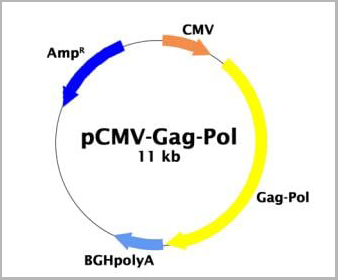Form/Format
10 ug at 0.25 ug/uL in TE
Plasmid Digestion
Single digestion: XbaI or SacII
Double digestion: NotI and XbaI yield 7.2 kb and 3.5 kb
Double digestion: NotI and XbaI yield 7.2 kb and 3.5 kb
Safety Consideration
Remember that you will be working with samples containing infectious virus. Follow the recommended NIH guidlines for all materials containing BSL-2 organisms. Always wear gloves , use filtered tips and work under a biosafety hood.
Preparation and Storage
Store at -20°C.
Related Product Information for pCMV-Gag-Pol retroviral vector
Retroviruses are efficient tools for delivering heritable genes into the genome of dividing cells. Moloney Murine Leukemia Virus (MMLV)-based retroviral vector system is the most commonly used gene transfer vehicle. pCMV-Gag-Pol expresses the retroviral structure proteins under the control of the CMV immediate-early promoter. The gag region encodes genes which comprise the capsid proteins; the pol region encodes the reverse transcriptase and integrase proteins.
Retrovirus can be produced using one of the following methods:
1) Transfection of a retrovirus packaging cell line with a retrovirus expression vector. Packaging cell lines usually stably express gag, pol and env genes. For example, transfection of Plat-E packaging cell line ( MBS169333 ) with a pMXs vector would produce an ecotropic retrovirus.
2) Cotransfection of a host cell with plasmids containing LTRs, Gag, Pol, Env. For example, cotransfection of 293RTV (MBS169332) with pMXs, pCMV-Gag-Pol (MBS168500) and pCMV-VSV-G (MBS168028) would produce VSVG-pseudotyped retrovirus.
Note: We recommend cotransfection of expression vector:gag-pol vector: envelope vector at the following plasmid ratios:
(a) For ecotropic or amphotropic retrovirus, 3:1:1
(b) For VSVG-pseudotyped retrovirus, 3:1:0.5
Retrovirus can be produced using one of the following methods:
1) Transfection of a retrovirus packaging cell line with a retrovirus expression vector. Packaging cell lines usually stably express gag, pol and env genes. For example, transfection of Plat-E packaging cell line ( MBS169333 ) with a pMXs vector would produce an ecotropic retrovirus.
2) Cotransfection of a host cell with plasmids containing LTRs, Gag, Pol, Env. For example, cotransfection of 293RTV (MBS169332) with pMXs, pCMV-Gag-Pol (MBS168500) and pCMV-VSV-G (MBS168028) would produce VSVG-pseudotyped retrovirus.
Note: We recommend cotransfection of expression vector:gag-pol vector: envelope vector at the following plasmid ratios:
(a) For ecotropic or amphotropic retrovirus, 3:1:1
(b) For VSVG-pseudotyped retrovirus, 3:1:0.5
Product Categories/Family for pCMV-Gag-Pol retroviral vector
References
1. Miller, A. D. & Baltimore, C. (1986) Mol. Cell. Biol. 6:2895-2902.
2. Mann, R., Mulligan, R. C. and Baltimore, D. (1983) Cell 33:153-159.
3. Morita, S., Kojim, T., and Kitamura, T. (2000) Gene Therapy 7: 1063-1066.
Okamoto, K. et al. (2012). Dengue Virus Strain DEN2 16681 Utilizes a Specific Glycochain of Syndecan-2 Proteoglycan as a Receptor. J.Gen. Virol. 93:761-770.
2. Mann, R., Mulligan, R. C. and Baltimore, D. (1983) Cell 33:153-159.
3. Morita, S., Kojim, T., and Kitamura, T. (2000) Gene Therapy 7: 1063-1066.
Okamoto, K. et al. (2012). Dengue Virus Strain DEN2 16681 Utilizes a Specific Glycochain of Syndecan-2 Proteoglycan as a Receptor. J.Gen. Virol. 93:761-770.
Similar Products
Product Notes
The pCMV-Gag-Pol (Catalog #AAA11418) is a Retroviral Vector and is intended for research purposes only. The product is available for immediate purchase. It is sometimes possible for the material contained within the vial of "pCMV-Gag-Pol, Retroviral Vector" to become dispersed throughout the inside of the vial, particularly around the seal of said vial, during shipment and storage. We always suggest centrifuging these vials to consolidate all of the liquid away from the lid and to the bottom of the vial prior to opening. Please be advised that certain products may require dry ice for shipping and that, if this is the case, an additional dry ice fee may also be required.Precautions
All products in the AAA Biotech catalog are strictly for research-use only, and are absolutely not suitable for use in any sort of medical, therapeutic, prophylactic, in-vivo, or diagnostic capacity. By purchasing a product from AAA Biotech, you are explicitly certifying that said products will be properly tested and used in line with industry standard. AAA Biotech and its authorized distribution partners reserve the right to refuse to fulfill any order if we have any indication that a purchaser may be intending to use a product outside of our accepted criteria.Disclaimer
Though we do strive to guarantee the information represented in this datasheet, AAA Biotech cannot be held responsible for any oversights or imprecisions. AAA Biotech reserves the right to adjust any aspect of this datasheet at any time and without notice. It is the responsibility of the customer to inform AAA Biotech of any product performance issues observed or experienced within 30 days of receipt of said product. To see additional details on this or any of our other policies, please see our Terms & Conditions page.Item has been added to Shopping Cart
If you are ready to order, navigate to Shopping Cart and get ready to checkout.





















